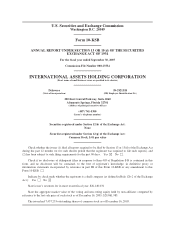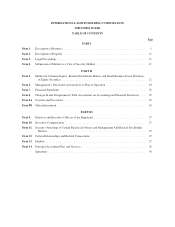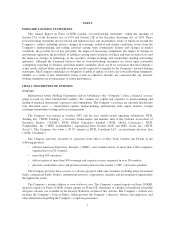INTL FCStone 2005 Annual Report Download - page 17
Download and view the complete annual report
Please find page 17 of the 2005 INTL FCStone annual report below. You can navigate through the pages in the report by either clicking on the pages listed below, or by using the keyword search tool below to find specific information within the annual report.Unexpected losses from market-making and trading activities
The Company conducts its market-making and trading activities predominantly as a principal, which
subjects its capital to significant risks. These activities involve the purchase, sale or short sale for the Company’s
own account of financial instruments, including equity and debt securities, commodities and foreign currencies.
These activities are subject to a number of risks, including risks of price fluctuations and rapid changes in the
liquidity of markets.
These risks may limit the Company’s ability either to resell financial instruments it purchased or to
repurchase instruments it sold in these transactions. In addition, the Company may experience difficulty
borrowing financial instruments to make delivery to purchasers to whom it sold short, or lenders from whom it
has borrowed. From time to time, the Company has large position concentrations in securities of a single issuer
or issuers in specific countries and markets. This concentration could result in higher trading losses than would
occur if the Company’s positions and activities were less concentrated.
The success of the Company’s market-making activities primarily depends on:
• the price volatility of specific securities
• the Company’s ability to attract order flow
• the skill of the Company’s personnel
• the availability of capital
• general market conditions
To attract market-making and trading business, the Company must be competitive in:
• providing enhanced liquidity to the Company’s customers
• the efficiency of the Company’s order execution
• the sophistication of the Company’s trading technology
• the quality of the Company’s customer service
In the Company’s role as a market-maker and trader, the Company attempts to derive a profit from the
difference between the prices at which it buys and sells financial instruments. However, competitive forces often
require the Company to:
• match the quotes other market-makers display
• hold varying amounts of securities in inventory
By having to maintain inventory positions, the Company is subjected to a higher degree of risk. Although
inventory risk management controls are in place, the Company may not be able to manage its inventory risk
successfully. Accordingly, the Company may experience significant losses, which could materially adversely
affect its business, financial condition and operating results.
Unexpected losses due to counterparty failures and credit concentration risks associated with our clearing
broker and custodians
As a market-maker of OTC and listed securities, the majority of the Company’s securities transactions are
conducted as principal with broker-dealer counterparties located in the United States. The Company clears its
securities transactions through an unaffiliated clearing broker. Substantially all of the Company’s equity and debt
securities are held by this clearing broker. The Company’s clearing broker has the right to charge the Company
for losses that result from a counterparty’s failure to fulfill its contractual obligations.
7
























